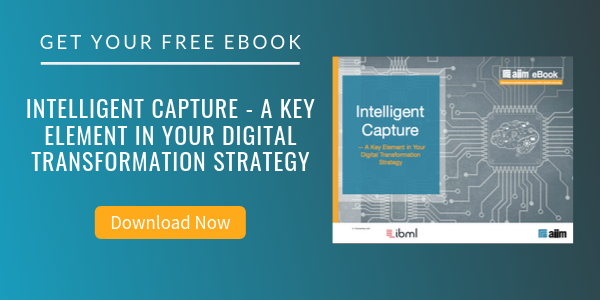
7 Reasons to Fear Free Puppies and Bundled Scanning Applications
We’ve all been there. There’s a pile of cute, fluffy, wriggling puppies in a crate. You lift one out for a quick cuddle. It licks you. It loves you. In minutes you grow to love the puppy back. Looking up, you see the sign… “Free puppies.” OMG, it can’t get any better than this! The transaction is completed, and you are now the happy owner of a free puppy, with whom you are in love. As you are walking away, the puppy purveyor reminds you to “get it to the vet for its shots.”

Within a week, without breaking a sweat, you have dropped $400 on this free puppy. That’s not all. You have also awakened to the daily maintenance associated with loving and owning a puppy. You have modified your schedule: Wake at 5:45 to let the puppy out. Walk the puppy before leaving for work. Come home every 2 hours to let the puppy out. Come home earlier than usual for the pre-dinner puppy walk. Take the puppy out before going to bed. Wake up once during the night to allow the whimpering pup to, once again, relieve itself. The good news is, it was “free.”
There is no such thing as a free puppy. There is also no such thing as a low-maintenance puppy.
How does this relate to scanning apps? It’s a fairly similar story, you just spend more money, and it wags a much bigger maintenance tail! Here goes…
You are attending a demo of your next new business application. (Take your pick…Finance and Accounting, ERP, Inventory, Recruiting, HR, Asset Management, Case Management, Incident Tracking, etc.)
Suddenly the sales guy says, “But that’s not all! It will also allow you to scan all the documents associated with the transaction, right into the software! That way, the images will live with the transaction, and you won’t have to do any more filing!” You begin to swoon! Then you get the best news…this scanning capability comes bundled into the software, so it’s FREE! You are now in love and decide to buy the new-fangled software package. They’re even going to throw in a scanner.
Like the puppy, this sounded like a great solution at the time. Here’s why it may create more problems than it solves.
New silos are created – One of the objectives in the development of document management (DM), and later enterprise content management (ECM) solutions was to eliminate information silos. Most of us remember the days when each department had its own set of file cabinets to house the business records that supported their work. Since it was difficult for people in other departments to get to them, they tended to have their own set of files. Version control did not exist. The main problem was the lack of a single source of the truth. Decisions were often made based on the wrong version of a document.
With the silos now living within the line-of-business applications, things are even worse. If you don’t have access to the software that holds the transactions, you can’t get to the underlying documents. So a project manager that needs ready access to the bills associated with a project must keep their own copies. New electronic silos are built with the same problems as the paper files of old.
Single point of access – A related issue is that documents can only be retrieved within the application into which they were scanned. Not only does the Finance system have its own scanning app, so do the HR, ERP, Facilities Management, and other key business systems. Using our project manager example, let’s examine the impact. The PM not only needs invoices from vendors, but they must also access timesheets, billings sent to the client, maintenance files related to the equipment in use on the project, and any documentation on capital items that were sold to the client for the project. In today’s LOB-based imaging world, these documents may now reside in multiple LOB applications. The notion of a single search to retrieve these disparate documents is not an option.
Licensing issues – Now we have a new problem. Our Project Manager has access to their project management system and the ERP, not the Finance system. Licenses aren’t cheap…and neither is the training required to use the system. Even if the only reason people have to log into the business system is to access the documents stored there, additional licenses and annual maintenance must be purchased. On top of that, the security matrix that must be built and maintained to grant document-only access and restrict access to other areas is difficult to set up and maintain. In many major business systems, this is not even possible.
Yet another workflow engine – The overhead created by supporting multiple workflow products is staggering. IT must have additional staff to configure and support the workflows. Extra licenses must be purchased to support the users, and everyone has to be trained on each workflow system. And if a workflow requires actions that touch several business systems, typically referred to as “swim-lane” processes, it just can’t be done.
Records retention issues – Most business systems do not support retention schedules. As a result, when it’s time to delete documents in accordance with the retention schedule, the organization has two choices: 1) Have an individual navigate to every transaction that has reached its expiration point and manually delete the images, or 2) write a script, if it is supported by the LOB application, to automatically perform the deletions. In either event, the added complexity of having a litigation hold in effect materially increases the complexity and cost of the process.
Finding documents related to one another is a pain – Let’s revisit our beleaguered project manager. Their focus is on the “project.” There are bills that are associated with POs, which are associated with change orders, which are associated with revised drawings, which are associated with new zoning events. If each of these items is housed in a different business system, there is no easy way to quickly search for everything related to the project, or easily study the documentation side-by-side.
Everyone becomes a scanner operator – Business system imaging applications tend to rely on users to scan items when the associated transactions are entered, or afterward as a separate task. This presents many unanticipated costs to the organization. First, everyone involved in adding documentation to the system must become adept at operating a scanner. They must have one available and convenient. They must remember to add the document every single time. They must take their valuable time to scan the documents. They must also know how to perform quality assurance steps to ensure all the pages are scanned, and the document is attached to the right transaction. The higher the pay-grade of the employee, the more this task costs. Finally, and most importantly, the process they must follow is slow. Economies of scale cannot be implemented under this model.
All these high-maintenance issues support the deployment of a single Enterprise Content Management (ECM) system to manage business records. Since most mature ECM systems provide seamless integration to most business applications and have workflow capability that can be applied to both document-centric and process-centric swim lane workflows, this solution overcomes all of the issues that are inherent in business system scanning apps.
Enjoy your free puppy. Leave the scanning to the ECM app.
About Paul Engel
I love applying technology to solving both simple and complex business problems. That's why ECM is such a great area of concentration. Eliminating manual paper-based processes and replacing them with rules-based workflows has a solid ROI and fixes so many business problems. Leading a national BPO practice populated by a group of totally committed, hard-working, smart people has no equal. I love coming to work every day. As long as that condition continues, I'll count myself lucky.



